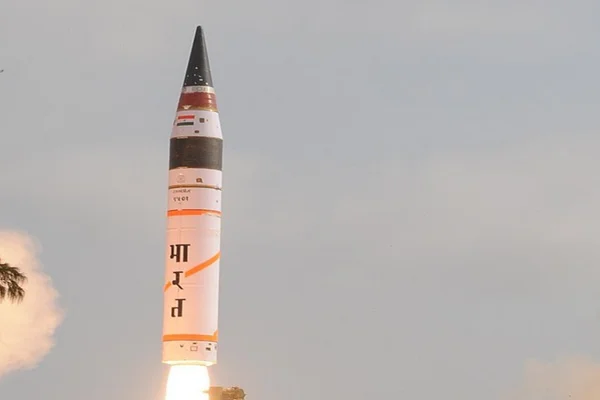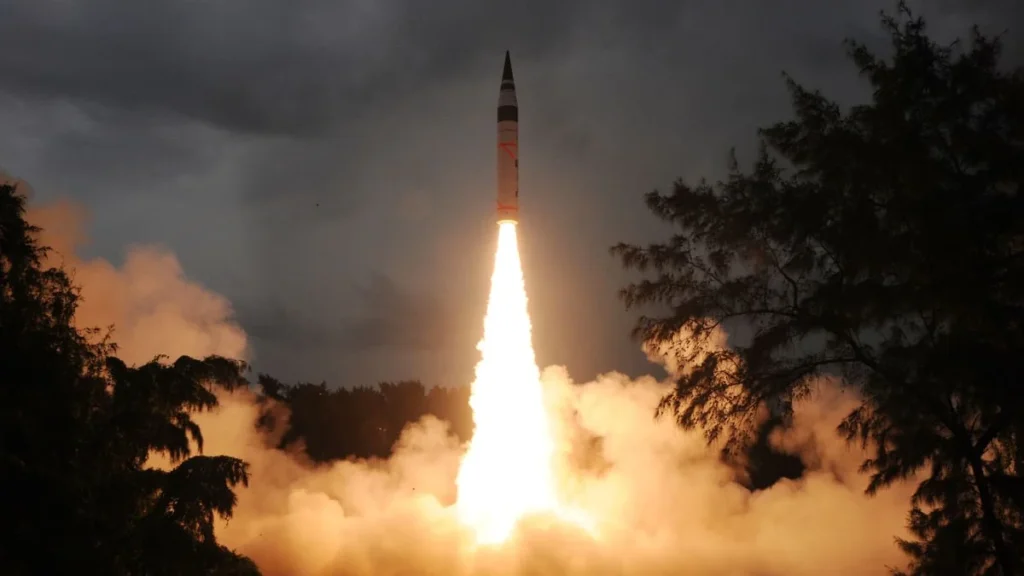Defence Research and Development Organisation (DRDO) conducted first successful flight test of indigenously developed Agni-5 missile with Multiple Independently Targetable Re-Entry Vehicle (MIRV) technology.
- The test, named Mission Divyastra, took place at Dr APJ Abdul Kalam Island in Odisha.
About Mission Divyastra:
- This is the first flight test of indigenously developed 5,000-km range Agni-5 nuclear missile, equipped with the Multiple Independently Targetable Re-entry Vehicle (MIRV) technology.
- It aims to deliver multiple warheads at different locations or at the same location in a single launch.
- The warheads could include decoys to deceive enemy’s ballistic missile programme.
- The Agni-5 MIRV is equipped with indigenous avionics systems and high accuracy sensor packages, which ensured that the re-entry vehicles reached the target points with precision.
Significance for India:
- India has for the first time publicly acknowledged to have successfully developed the MIRV technology that was found in the 1960s by major countries, including China.
- India has joined an exclusive group of nationspossessing MIRV technology.
- At present, the US, UK, France, China, Russia and India are among the elite group that possesses the technology.
- In 2017, Pakistan reportedly tested a MIRVed missile, the Ababeel.
- The success of the Divyastra test signifies India’s mastery of the technology for miniature warheads.
About MIRV technology:
- MIRVs have revolutionized ballistic missile payloads, allowing a single missile to carry multiple warheads, each capable of targeting enemies at different locations.
- They can be launched from either land-based or submarine platforms.
- The technology was initially introduced in the US with the successful test of the Minuteman III in 1968, leading to its practical deployment in the 1970s.
- By the late 1970s, the Soviet Union had developed its own MIRV-enabled Intercontinental Ballistic Missile (ICBM) and Submarine-Launched Ballistic Missile (SLBM) technology.
- Warheads on MIRVs can be launched at varying speeds and trajectories, enabling them to hit targets as far as 1,500 km apart.
- The technology requires a delicate combination of large missiles, small warheads, precise guidance, and a complex mechanism for releasing warheads sequentially during flight.
How does MIRV work?
- An MIRV-equipped missile follows a trajectory into space similar to other ballistic missiles.
- Following the boost phase, the missile’s upper stage, known as the ‘bus’, enters suborbital spaceflight and aligns itself based on designated targets.
- The “bus” sequentially deploys multiple warheads, alongside decoys and countermeasures. Each warhead can be assigned a distinct target or trajectory.
- After the deployment, the warheads re-enter the Earth’s atmosphere and proceed to their respective targets.
Challenges:
- The MIRV technology enhances first-strike proficiency and complicates the calculus of mutual assured destruction.
- The strategic shift initiated by MIRV technology has allowed numerous nations to inflict greater damage on targets and diminish the effectiveness of enemy missile systems, fundamentally changing the landscape of global nuclear deterrence.
- With the ability to deploy multiple warheads from a single missile, nations can achieve a broader spread of targets, making the defence system less effective and more costly.
- Although MIRVs were not initially made to defeat ballistic missile defences, they are much more difficult to defend against than traditional missiles.
About Agni-5 Missile:
- The Agni-5 is an intermediate-range ballistic missile (IRBM) developed by India’s DRDO.
- The development of Agni missiles commenced in the early 1980s under the Integrated Guided Missile Development Programme led by DRDO, under the leadership of Dr. A. P. J. Abdul Kalam.
- It has a range of 5,000 kilometers and can potentially enter the intercontinental range, which is 5,500 kilometers and above.
- The Agni-5 has a 3-stage solid rocket engine and uses solid fuel as propellant.
Other Agni Missiles:
- The Agni missile is a family of surface-to-surface medium to intercontinental range ballistic missiles developed by DRDO.
- The range of the Agni missile systems, ranging from Agni-1 to Agni-5, varies from 700 km for Agni-1 to over 5000 km for Agni-5.
- DRDO conducted a successful test of Agni Prime (Agni p), a canisterized missile with a range capability between 1,000 and 2,000 km.
- The Agni P is a two-stage canisterized solid propellant ballistic missile equipped with a dual redundant navigation and guidance system.
- This feature allows the missile to be launched from road and rail platforms, facilitating easier deployment and faster launch capabilities.
Ref:Source
| UPSC IAS Preparation Resources | |
| Current Affairs Analysis | Topperspedia |
| GS Shots | Simply Explained |
| Daily Flash Cards | Daily Quiz |



